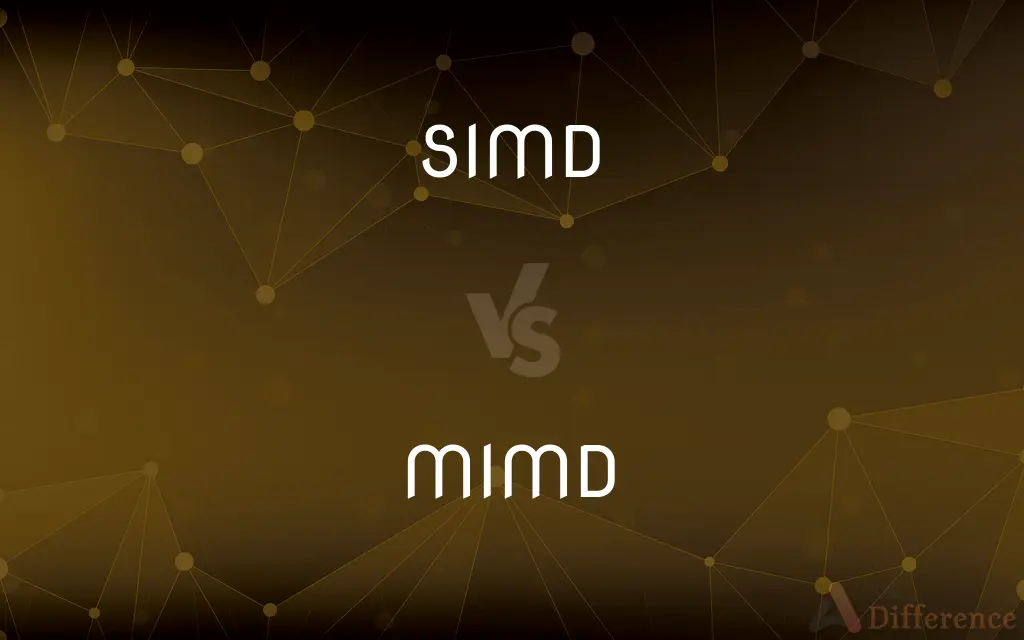SIMD vs. MIMD — What's the Difference?
By Tayyaba Rehman & Urooj Arif — Published on January 31, 2024
SIMD (Single Instruction, Multiple Data) processes multiple data points with one instruction. MIMD (Multiple Instruction, Multiple Data) performs different instructions on different data simultaneously.

Difference Between SIMD and MIMD
Table of Contents
ADVERTISEMENT
Key Differences
SIMD, standing for Single Instruction, Multiple Data, is a computing method where one operation is performed on multiple data points simultaneously. In contrast, MIMD, or Multiple Instruction, Multiple Data, refers to a process where multiple processors execute different instructions on different data points at the same time. SIMD is commonly used for tasks with a high degree of data parallelism, while MIMD is more versatile, handling various tasks independently.
In SIMD architectures, a single control unit dispatches the same instruction to multiple processors, which then execute it on different pieces of data. This approach is highly efficient for vector processing and matrix calculations. MIMD architectures, however, consist of several processors that can execute different instructions on different data sets concurrently. This makes MIMD suitable for complex, diverse computing tasks that require multitasking.
The strength of SIMD lies in its ability to accelerate computational tasks that can be parallelized, such as graphics processing and scientific simulations. It achieves high data throughput and efficiency for such specific tasks. On the other hand, MIMD systems excel in scenarios where flexibility and adaptability are key. They can handle a mix of different operations and workloads, making them ideal for general-purpose computing and multi-user environments.
While SIMD systems are simpler in terms of hardware control logic, as they only need to handle a single instruction at any given time, they are limited by the uniformity of operations they can perform. In contrast, the complexity of MIMD systems lies in coordinating various independent processors, yet this complexity allows for greater flexibility and the ability to execute a wide range of tasks concurrently.
In summary, SIMD and MIMD are two distinct approaches in parallel computing, each with its own set of advantages. SIMD is optimized for uniform operations on large data sets, making it efficient for specific types of calculations. MIMD, with its capability to handle multiple, diverse instructions concurrently, offers greater versatility and is better suited for general-purpose and multitasking environments.
ADVERTISEMENT
Comparison Chart
Instruction Flow
Single instruction to multiple data points.
Multiple instructions to multiple data points.
Data Processing
Uniform operations on parallel data.
Different operations on different data.
Use Cases
Ideal for graphics, simulations.
Suited for general computing, multitasking.
Flexibility
Limited to parallelizable tasks.
Highly adaptable to various tasks.
Hardware Complexity
Simpler control logic.
Complex due to independent processors.
Compare with Definitions
SIMD
SIMD is utilized for tasks with repetitive, parallel data processing.
Image processing algorithms often leverage SIMD for efficient pixel manipulation.
MIMD
MIMD allows multiple processors to execute different instructions independently.
In a MIMD system, one processor can perform data sorting while another handles encryption.
SIMD
SIMD operates under a single control unit directing multiple processors.
SIMD's single control unit efficiently coordinates the simultaneous processing of array elements.
MIMD
MIMD provides flexibility in parallel computing by executing different tasks concurrently.
MIMD computing is beneficial in distributed systems where diverse computational needs arise.
SIMD
SIMD enhances throughput for uniform computational tasks.
SIMD architectures are effective in executing large-scale matrix multiplications.
MIMD
MIMD is characterized by its multitasking capabilities across processors.
A MIMD setup can simultaneously manage database queries and scientific calculations.
SIMD
SIMD architecture achieves data-level parallelism.
SIMD is essential in accelerating vector operations in scientific computations.
MIMD
MIMD systems are versatile, handling a variety of instructions and data.
MIMD architectures excel in environments like servers, where varied tasks occur concurrently.
SIMD
SIMD processes the same operation on multiple data points simultaneously.
In graphics rendering, SIMD architecture speeds up the processing of each pixel uniformly.
MIMD
MIMD supports diverse computational tasks simultaneously.
MIMD architectures are ideal for complex simulations involving various independent processes.
Common Curiosities
What is MIMD?
MIMD stands for Multiple Instruction, Multiple Data, a computing architecture where different processors execute different instructions on different data sets concurrently.
What are typical use cases for SIMD?
SIMD is typically used in tasks with high data parallelism, such as graphics processing and scientific simulations.
What are typical use cases for MIMD?
MIMD is suited for general-purpose computing and multitasking, handling a variety of tasks independently.
Is SIMD more efficient than MIMD?
SIMD is more efficient for specific parallelizable tasks, while MIMD offers greater versatility for diverse tasks.
How does SIMD differ from MIMD in data processing?
SIMD processes the same operation on multiple data points at once, while MIMD performs different operations on different data points simultaneously.
What is the hardware complexity of SIMD compared to MIMD?
SIMD has simpler control logic as it handles a single instruction, while MIMD is more complex due to coordinating multiple independent processors.
What is SIMD?
SIMD stands for Single Instruction, Multiple Data, a parallel computing architecture where a single instruction operates on multiple data points simultaneously.
Can MIMD handle more complex tasks than SIMD?
Yes, MIMD can handle more complex and diverse tasks due to its ability to execute multiple independent instructions.
Which is better for graphics processing, SIMD or MIMD?
SIMD is generally better for graphics processing due to its efficient parallel data handling.
Can MIMD architectures handle multitasking effectively?
Yes, MIMD architectures are highly effective in multitasking environments.
How does SIMD impact data throughput?
SIMD increases data throughput for parallelizable tasks by processing multiple data points simultaneously.
Are SIMD and MIMD mutually exclusive in systems?
No, some systems can utilize both SIMD and MIMD architectures for different tasks.
Is SIMD limited to specific types of calculations?
Yes, SIMD is most efficient for calculations that can be parallelized.
Are there any scalability differences between SIMD and MIMD?
MIMD is generally more scalable for diverse and complex tasks compared to SIMD.
What makes MIMD suitable for multi-user environments?
MIMD's ability to handle multiple, independent tasks concurrently makes it suitable for multi-user environments.
Share Your Discovery

Previous Comparison
Classification Algorithm vs. Regression Algorithm
Next Comparison
Nintendo Wii U vs. WiiAuthor Spotlight
Written by
Tayyaba RehmanTayyaba Rehman is a distinguished writer, currently serving as a primary contributor to askdifference.com. As a researcher in semantics and etymology, Tayyaba's passion for the complexity of languages and their distinctions has found a perfect home on the platform. Tayyaba delves into the intricacies of language, distinguishing between commonly confused words and phrases, thereby providing clarity for readers worldwide.
Co-written by
Urooj ArifUrooj is a skilled content writer at Ask Difference, known for her exceptional ability to simplify complex topics into engaging and informative content. With a passion for research and a flair for clear, concise writing, she consistently delivers articles that resonate with our diverse audience.
















































